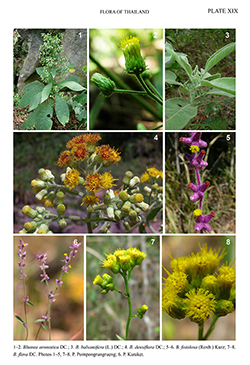e-Flora of Thailand
Volume 13 > Part 2 > Year 2016 > Page 208 > Compositae (Asteraceae) > Blumea
6. Blumea flava DC.wfo-0000068991
Prodr. 5: 439. 1836.— Laggera flava (DC.) C.B.Clarke, Compos. Ind. 90. 1876.— Blumeopsis flava (DC.) Gagnep., Bull. Mus. Natl. Hist. Nat. 26: 76. 1920. Plate XIX: 7–8.
Accepted Name : This is currently accepted.
Synonyms & Citations :
Description : Annual herb, 0.15–1 m tall; stems erect, glabrous. Leaves in a subbasal rosette and cauline, sessile, ovate or broadly elliptic, 1–10 by 0.5–4 cm, apex acuminate, base attenuate or semi-amplexicaul, subrosulate at base of stem, margins serrate or spinulose dentate, coriaceous, bright green, glabrous on both sides; cauline leaves alternate, sessile, 1.5–10 by 0.5–5 cm, apex acuminate, base amplexicaul, margins serrate or spinulose dentate, coriaceous, bright green, glabrous on both sides. Inflorescences terminal, corymbose panicles, 4–20 cm long. Capitula 3–4 mm diam.; peduncles slender, 1–10 mm long; involucres campanulate-globose; phyllaries 5-seriate, outer herbaceous, ovate, apex obtuse to acute and puberulous, inner linear-oblong, apex acuminate; receptacle 2–4 mm diam., convex, areolate, pilose. Marginal floret corollas yellow, basal tube 5.7–6.2 mm long, lobes generally glabrous. Disc floret corollas yellow, basal tube 5.7–6 mm long, glabrous, lobes oblong-lanceolate, 0.5–0.6 mm long, glabrous, with glandular hairs; anthers 1.4–1.5 mm long, apical appendages round, bases with branched tails, anther-tails longer than anther collars or sagittate without tails; style arms 1–1.1 mm long, base swollen, sweeping hairs obtuse, distributed to below style bifurcation. Achenes oblong, 10-ribbed, 2–5 mm long, glabrous; pappus bristles 17–22, 6–7 mm long, caducous, white.
Thailand : NORTHERN: Mae Hong Son (Khun Yuam, Ban Huai Hi, Pai, Mo Paeng Falls), Chiang Mai (Khun Khong, Doi Pha Hom Pok, Doi Suthep, Doi Chiang Dao, Doi Angka, Mae Klang Falls, Ban Yang, Doi Inthanon, Mae Pau, Sop Ap, Mae Hoi, Mae Chia-Ban, Mae Kon, Doi Chang, Mae Sanam, Omkoi, Maelit Bridge, Mae Pan Falls, Mae Sao Watershed Management Station), Chiang Rai (Doi Phacho, Chiang Khan), Lampang (Huai Maesan, Khun Tan NP, Chae Son NP), Nan (Pha Sing), Tak (Khao Phra Wo, Raheng, Umphang); NORTH-EASTERN: Phetchabun (Nam Nao NP, Thung Salaeng Luang NP), Loei (Phu Kradueng, Phu Luang), Nong Khai (Sangkhom), Sakon Nakhon (Phu Phan NP), Nakhon Phanom, Mukdahan (Dongman, Phu Mu NP), Khon Kaen (Mo Din Daeng, Phu Wiang NP, Phu Ta Ka, Wiang Kao); EASTERN: Chaiyaphum (Huai Pathao, Phu Khiao), Nakhon Ratchasima (Nong Phakchi, Khao Yai NP), Ubon Ratchathani (Chong Mek); SOUTH-WESTERN: Uthai Thani (Huai Kha Kaeng WS); Kanchanaburi (Huai Bankao, Thong Phaphum); SOUTH-EASTERN: Trat (Ko Chang); PENINSULAR: Phangnga (Ko Kho Khao).
Distribution : Pakistan, India (Eastern India – type, Bengal, Mysore), Nepal (type of Laggera falcata Kuntze), Sikkim, Bhutan, Myanmar, China (Yunnan, Guizhou, Guangdong), Indochina, Malaysia, Indonesia (Sumatra).
Ecology : Dry grassy slopes in old clearings, mixed deciduous and dipterocarp forests, pine-oak forests, 450–1,800 m alt. Flowering: November–March.
Vernacular : Phakkat khok (ผักกาดโคก)(Northeastern, Loei); ngueak pla mo pa (เหงือกปลาหมอป่า)(Sukhothai).

